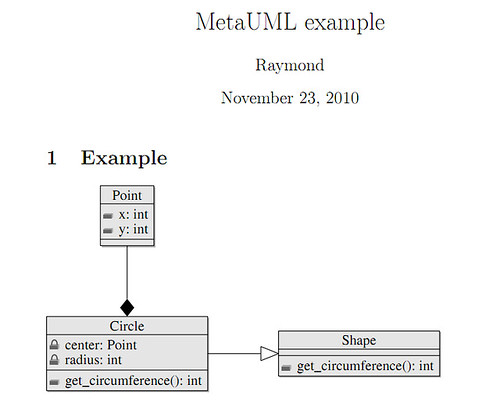draw uml with latex&metauml
I've used and enjoyed the benefits of reversion control system for several years. RCS makes my life a lot easier. And it pushes me to highly prefer text format files over binary files, because text files can be managed by RCS more easily. metauml is a metapost library for creating uml diagrams, in text format.
Here are the steps to use it on ubuntu:
After all these tools have being installed, we can start our first uml diagram in latex.
Suppose we have following classes, and want to draw class diagram for them.
We create below metapost file, save it as class_diagram.mp, and use "mpost class_diagram.mp" command to generate a postscript file, class_diagram.1.
Then we create below tex file as a container document for the postscript. And use "pdflatex uml.tex" to generate the final pdf file.
The final diagram is shown below:
The advantages of using tex file to draw uml diagram includes:
Here are the steps to use it on ubuntu:
- install texlive with: sudo apt-get install texlive
- install metauml containing in metapost for tex: sudo apt-get install texlive-metapost
After all these tools have being installed, we can start our first uml diagram in latex.
Suppose we have following classes, and want to draw class diagram for them.
1 class Point
2 {
3 public:
4 int x;
5 int y;
6 };
7
8 class Shape
9 {
10 public:
11 virtual int get_circumference() = 0;
12 virtual ~shape();
13 };
14
15 class Circle : public Shape
16 {
17 private:
18 Point center;
19 int radius;
20 public:
21 int get_circumference();
22 };
2 {
3 public:
4 int x;
5 int y;
6 };
7
8 class Shape
9 {
10 public:
11 virtual int get_circumference() = 0;
12 virtual ~shape();
13 };
14
15 class Circle : public Shape
16 {
17 private:
18 Point center;
19 int radius;
20 public:
21 int get_circumference();
22 };
We create below metapost file, save it as class_diagram.mp, and use "mpost class_diagram.mp" command to generate a postscript file, class_diagram.1.
1 input metauml;
2 beginfig(1);
3 %define classes
4 Class.Point("Point")("+x: int", "+y: int")();
5 Class.Shape("Shape")()("+get_circumference(): int");
6 Class.Circle("Circle")("-center: Point", "-radius: int")("+get_circumference(): int");
7
8 %layout classes
9 topToBottom(50)(Point, Circle);
10 leftToRight(50)(Circle, Shape);
11
12 %draw classes
13 drawObjects(Point, Shape, Circle);
14
15 %link classes
16 link(inheritance)(Circle.e -- Shape.w);
17 link(composition)(Point.s -- Circle.n);
18 endfig;
19 end
20
2 beginfig(1);
3 %define classes
4 Class.Point("Point")("+x: int", "+y: int")();
5 Class.Shape("Shape")()("+get_circumference(): int");
6 Class.Circle("Circle")("-center: Point", "-radius: int")("+get_circumference(): int");
7
8 %layout classes
9 topToBottom(50)(Point, Circle);
10 leftToRight(50)(Circle, Shape);
11
12 %draw classes
13 drawObjects(Point, Shape, Circle);
14
15 %link classes
16 link(inheritance)(Circle.e -- Shape.w);
17 link(composition)(Point.s -- Circle.n);
18 endfig;
19 end
20
Then we create below tex file as a container document for the postscript. And use "pdflatex uml.tex" to generate the final pdf file.
1 \documentclass{article}
2
3 % The following is needed in order to make the code compatible
4 % with both latex/dvips and pdflatex.
5 \ifx\pdftexversion\undefined
6 \usepackage[dvips]{graphicx}
7 \else
8 \usepackage[pdftex]{graphicx}
9 \DeclareGraphicsRule{*}{mps}{*}{}
10 \fi
11
12 \title{MetaUML example}
13 \author{Raymond Wen}
14
15 \begin{document}
16
17 \maketitle
18
19 \section{Example}
20 \includegraphics{class_diagram.1}
21
22 \end{document}
2
3 % The following is needed in order to make the code compatible
4 % with both latex/dvips and pdflatex.
5 \ifx\pdftexversion\undefined
6 \usepackage[dvips]{graphicx}
7 \else
8 \usepackage[pdftex]{graphicx}
9 \DeclareGraphicsRule{*}{mps}{*}{}
10 \fi
11
12 \title{MetaUML example}
13 \author{Raymond Wen}
14
15 \begin{document}
16
17 \maketitle
18
19 \section{Example}
20 \includegraphics{class_diagram.1}
21
22 \end{document}
The final diagram is shown below:
The advantages of using tex file to draw uml diagram includes:
- The diagram can be easily version controlled and compared
- It's easier to make modifications
- It's totally free
- The output file format can be easily changed
- It's possible to use/write tools to generate uml diagram automatically




